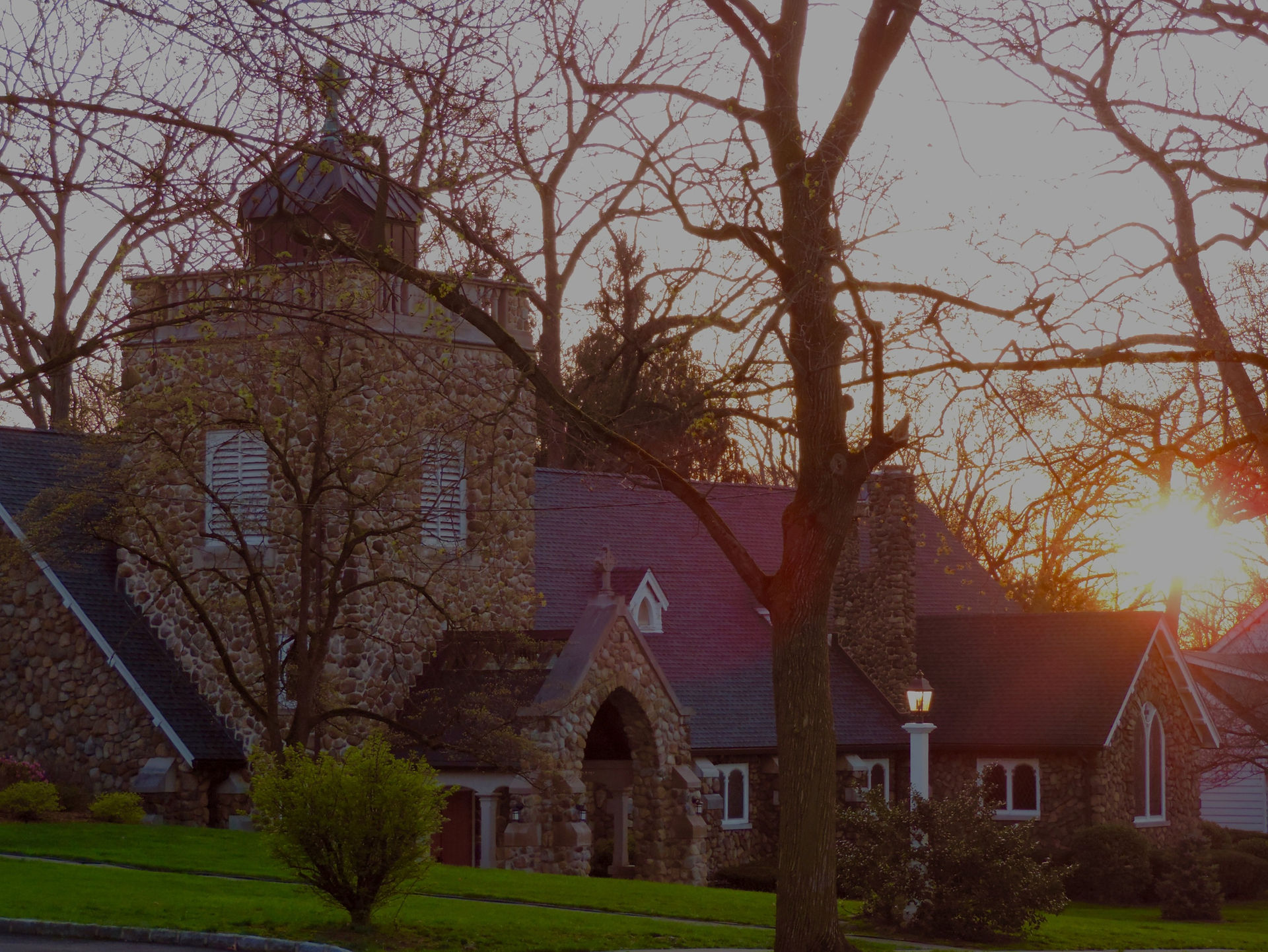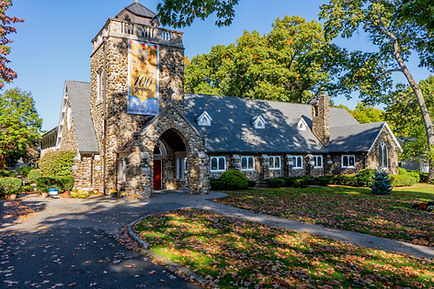
Buildings and Grounds
The Church
Completed in 1923, St. Elizabeth’s was originally a small chapel built in the English Arts and Crafts style, popular at that time. It was expanded in 1957 to its current size, adding a balcony, narthex, and bell tower as well. The leadership of the church was determined to make the addition as seamless as possible, and except for the line in the floorboards it is almost impossible to tell where the original church ends and the 1957 construction begins. The additional stones needed for the 1957 addition were acid washed to match the weathering of original building, and the original scissor beams were faithfully copied and stained to match. The simple and dignified design compliments our “broad church” worship practice, and the interior with its warm oak pews, carved pulpit, and dramatic scissor beams reflect the craftsmanship of earlier times. Needlepoint cushions and kneelers made by parishioners decorate the sanctuary.

One of the tenets of the Arts and Crafts aesthetic is to use local materials and show the craftsmanship. What could be more local than the church’s exterior, for it was constructed of fieldstones from the property that surfaced when digging for the foundation! The story goes that when the future first warden, Mr. Albert Leonhard, visited the construction site and saw all the stones that would have to be hauled away at a cost, he offered to cover the expense of converting the building from a wooden frame structure to one out of stone. He had given the land for the building, and was the then-warden of St. Bartholomew’s Church in Ho-Ho-Kus, the sponsoring parish for St. Elizabeth’s. In recognition of his generosity, the Vestry voted to name the church after his late wife. English Arts and Crafts architecture uses details borrowed from the Gothic style, as Gothic was considered “authentic” because local craftsmen created it. Examples of this at St. Elizabeth’s are the Gothic arches in the chancel, the choir benches facing each other as they would in a medieval church, and the stained glass windows, especially the rose window (see ”Windows” for more description). This all contributes to a feeling that the building is much older than it really is. Even the chimney for the long-gone coal furnace is disguised as a campanile or small bell tower for a Sanctus bell. The 1957 tower began to pull away from the building in the early years of the 21st century, and so was redesigned and rebuilt in 2014. It now has a porch to support it, a “lantern” at the top of the tower, and a parapet featuring designs of different crosses, continuing the theme of the clerestory windows. Four new bells were added to the tower (see “Bells” for more description.)
The Memorial Garden
St. Elizabeth’s property includes a Memorial Garden just to the north of the sanctuary where we inter the ashes of members who have entered their larger life with God. Every All Saints’ Day we include in our prayers the names of all who have been interred in the Garden.
The Children's Garden
A generous gift enabled us to establish a Children’s Garden at the entry to our new building.
The Organ
On October 12, 2014 the Schantz Organ console, which was built for St. Elizabeth’s in 1986, played its final Sunday service. For many years the console, antiphonal console, and pipes brought an enormous improvement to the musical life at St. Elizabeth’s thanks to the efforts of Dick Andersen, Frank Archer, and the support of the congregation of St. Elizabeth’s. In recent years, due in part to the adventurous mice in the sanctuary, the console began to fail. George Swope was a frequent emergency room doctor to the organ console, helping us keep the organ console reasonably functional for many years. The “For All the Saints” capital campaign allocated funding to replace the console. A new three-manual console built by Patrick J. Murphy and Associates was delivered and installed.
The Bells
We introduced four new bells on Flower Sunday in June 2013, dedicating them on All Saints’ Sunday in November 2013, and because only a bishop may actually bless bells in our tradition, Bishop Mark Beckwith blessed our bells on Sunday, January 12, 2014. This is the text of the prayer he used: Almighty God, creator of heaven and earth, grant that these bells, given to proclaim your glory, may always raise the hearts and spirits of your people to stand in awe before your power, to delight in the mystery of your beauty, and to join in the proclamation of your gracious rule in this age and for ever more: may the notes of these bells be as our prayers rising to you, and may their music be as your words coming down to us, and all of this we pray at the invitation of your Holy Spirit and in the Name of your Only Son, Jesus Christ, our savior and our Lord. Amen.
The sally is the thick portion of the rope, made from dyed wool, which forms the hand-hold for the ringer. The ropes and sallys are given to the glory of God and in thanksgiving for the life of David Harper, who served as St. Elizabeth’s Master of the Bell untill his death in 2010.
The Lightner Memorial Bell has been in use at St. Elizabeth’s (for 38 years) since.
Bell #2, the Democracy Bell Note: B—31.5” diameter, 704 lbs. Sally: Red, White, and Blue To the Glory of God and in thanksgiving for the blessings of freedom, justice, democracy, and peace.
Bell #3, the Parents’ and Grandparents’ Bell Note: D—26.1875” diameter, 407 lbs. Sally: Burgundy To the Glory of God and in loving memory of Irving M. Smith and Martha L. Smith Brady.
Bell #4, the Musicians’ Bell Note: E—23.25” diameter, 290 lbs. Sally: Blue To the Glory of God and in thanksgiving for Richard Andersen, Frank Archer, and all who work together to share the gift of music.
Bell #5, the Children’s Bell Note: G—20.375” diameter, 198 lbs. Sally: Green To the Glory of God and in thanksgiving for the children of our community.
Weather Vane Honors Longtime Parishioner Doris Harper.
At the 10 a.m. service on Sunday, December 11, 2012, The Rev. Cn. John Hartnett unveiled a weather vane, commissioned for St. Elizabeth's to honor Doris Harper's contriubutions to the Garden Committee over the years.
